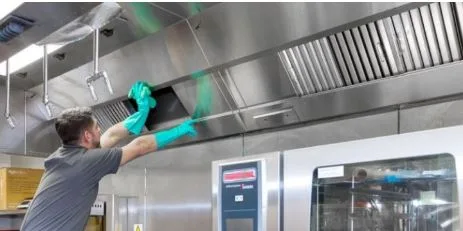How Often Should You Schedule Kitchen Hood Cleaning Services?
If you run a restaurant, café, food truck, or any commercial kitchen, your exhaust hood is one of the hardest-working pieces of safety equipment you own. It captures airborne grease, smoke, and heat, then channels it away from your cooking line. But that grease doesn’t disappear—it accumulates in the hood, filters, ductwork, and fan. Left unchecked, buildup becomes a fire hazard, hurts ventilation, and can even void your insurance. So the question isn’t if you should clean your hood; it’s how often. This guide breaks down practical timelines, the variables that affect them, and how to build a cleaning calendar that keeps you compliant and safe.
Why cleaning frequency matters
- Fire prevention: Grease is highly flammable. Even a thin film can ignite when exposed to high heat or flames. Regular cleaning reduces fuel for potential fires.
- Stronger ventilation: A clean system moves more air, helping manage kitchen temperatures, smoke, and odors—making shifts more comfortable and productive.
- Health & hygiene: Grease and moisture provide a home for bacteria and pests. Clean systems support a safer food environment.
- Compliance and insurance: Many local fire codes and insurers require routine hood cleaning—often with documentation. Staying on schedule protects your permits and coverage.
- Equipment life & energy costs: Fans and motors work harder when ducts are clogged. Cleaning keeps components running efficiently and extends their lifespan.
Typical schedules for commercial kitchens
There’s no one-size-fits-all answer because menus, volume, and cooking methods vary. That said, most operations fall into four cadence buckets:
- Monthly:
- Who it fits: Solid-fuel cooking (wood or charcoal), high-volume frying, or heavy wok operations.
- Why: These techniques produce heavy, sticky grease that accumulates rapidly throughout the system.
- Quarterly (every 3 months):
- Who it fits: Busy, full-service restaurants, quick-service concepts, chains with consistent high throughput.
- Why: Constant use plus high-heat cooking means ducts and fans load up quickly.
- Semiannually (every 6 months):
- Who it fits: Moderate-volume restaurants, caterers, or kitchens with varied but not relentless line hours.
- Why: Grease accumulates steadily but not as aggressively as in fast-casual or fried-food-centric menus.
- Annually (every 12 months):
- Who it fits: Low-volume operations, seasonal kitchens, or facilities with limited cooking (e.g., churches, small cafés, some schools).
- Why: Intermittent use leads to slower buildup, though an annual deep clean is still essential.
Pro tip: Start conservative (more frequent), monitor how quickly grease returns, then fine-tune. It’s easier to scale back than to deal with a citation—or a fire.
Factors that change your ideal cadence
Even within the same category, you’ll find big differences. Look at these variables to dial in your schedule:
- Cooking method: Fryers, woks, griddles, and charbroilers output more grease than ovens or steamers. Solid-fuel grill? Plan on the most frequent cleanings.
- Menu composition: If fried items or high-fat proteins dominate, expect faster buildup.
- Hours of operation: Breakfast-to-late-night service or 24/7 operations need more frequent service than a lunch-only café.
- Kitchen volume & seasonality: Tourist towns, campus rushes, or sports seasons can spike grease loads. Increase service during peak months.
- Ventilation design: Long duct runs, multiple turns, or older systems trap more grease. Ditto for undersized fans.
- Filter type & maintenance: Baffle filters perform better when washed nightly. Neglected filters push more grease downstream into ducts.
- Local code & landlord rules: Some jurisdictions specify minimum intervals; some property managers require proof of cleaning for common insurance policies.
Signs you’re overdue (and should book ASAP)
- Visible, sticky residue on hood surfaces, around light fixtures, or on the roof near the fan.
- Filters clog quickly or look dark and tacky even after washing.
- Persistent smoke or odors linger after service or during prep.
- Hotter kitchen & poor airflow—staff complain that ventilation “doesn’t pull like it used to.”
- Grease drips from duct seams or the fan housing.
- Failed or borderline inspections—or a warning from your fire suppression technician.
If any of these show up, move your cleaning up on the calendar and reassess your regular frequency.
What professional hood cleaning should include
A legitimate provider does far more than wipe the hood’s exterior. Expect a top-to-bottom service that includes:
- Prep & protection: Cover cooking equipment and floors; set containment for wastewater and debris.
- Disassembly: Remove filters, access panels, and fan components as needed.
- Degreasing the entire system:
- Hood interior (canopy and plenum)
- Baffle filters (or swap for cleaned spares)
- Vertical and horizontal ductwork (all accessible areas)
- Rooftop exhaust fan and housing
- Rinse & polish: Neutralize chemicals, rinse thoroughly, and polish stainless surfaces.
- Reassembly & function check: Verify fan balance, belts, and operation.
- Before/after photos: Documented evidence for compliance, insurance, and landlord requirements.
- Certificate of performance: Dated record of service detailing areas cleaned and any issues found.
When comparing estimates, ask what’s included. A low price that skips ducts or the fan isn’t a bargain—it’s a risk.
DIY vs. professional cleaning
- DIY (daily/weekly): Staff should remove and wash baffle filters regularly (often nightly for heavy use), wipe visible hood surfaces during closing, and keep surrounding areas grease-free. This does not replace duct and fan cleaning.
- Professional (periodic): Only trained technicians with the right tools, chemicals, and access methods can properly clean deep inside ducts and the rooftop fan assembly. They’ll also minimize mess and ensure wastewater is handled responsibly.
Think of DIY as maintenance and professional service as risk control. Both are necessary.
How to choose the right provider (and protect your kitchen)
Your hood cleaning partner is part of your safety team. Vet them like you would a fire suppression contractor:
- Ask about scope: They should clean the hood, ducts, and fan—not just what you can see. Confirm access to vertical sections and tricky elbows.
- Verify experience: Seek providers who specialize in commercial kitchen hood cleaning services and can share references from similar operations.
- Check documentation: Insist on before/after photos and a certificate after each visit. This is your proof for inspectors and insurers.
- Confirm insurance & safety practices: They should carry liability insurance, follow OSHA safety protocols, and protect your roof membrane and equipment.
- Assess scheduling flexibility: Can they work during off-hours or between dayparts? Fast, low-disruption service matters in a busy kitchen.
- Evaluate communication: You want clear reports, recommendations for repair or access panels, and reminders for next service.
A reputable provider won’t just clean; they’ll help you optimize your cadence based on what they see inside your system over time.
Building your maintenance calendar
Use this simple framework to set and stick to a schedule:
- Start with a baseline:
- Solid-fuel or heavy frying: Monthly
- High-volume restaurants: Quarterly
- Moderate-volume: Semiannual
- Low-volume/seasonal: Annual
- Layer in daily/weekly tasks: Train closing crews to wash filters, wipe the hood, and log quick checks (smells, smoke, visible residue).
- Log everything: Keep a binder or digital folder with service certificates, photos, and staff maintenance logs. This makes inspections painless.
- Review quarterly: Use your provider’s photos to decide if you can extend or should tighten the cadence. Kitchens evolve—your calendar should, too.
- Plan around peaks: Add mid-season cleanings before and after known rush periods (holidays, festival season, campus move-ins).
FAQs
What if my filters are cleaned nightly—can I stretch professional cleanings?
Maybe a little, but not much. Clean filters help, yet grease still travels into the plenum, ducts, and fan over time.
Do I need to shut down the kitchen?
Most services happen during off-hours. Expect some downtime while equipment is covered and the system is cleaned and reassembled.
How long does it take?
Time varies by system complexity and how long it’s been since your last cleaning. Larger, dirtier systems take longer—another reason to stay on schedule.
Will cleaning damage my roof?
It shouldn’t. Pros use containment, protect membranes, and clean up thoroughly. Ask about roof-safe procedures beforehand.
The bottom line
A clean hood system is non-negotiable for fire safety, air quality, compliance, and equipment health. While monthly to annual intervals are common, your ideal cadence depends on cooking methods, volume, and ventilation design. Pair consistent daily filter care with a reliable partner for commercial kitchen hood cleaning services, keep good records, and adjust based on real-world grease buildup. Do that, and you’ll protect your team, your guests, and your bottom line—without surprises at inspection time.



